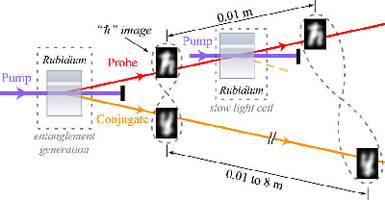Collaborative Research addresses delayed entanglement.
Share:

Press Release Summary:

Researchers from NIST and the University of Maryland have announced a growing ability to control the quantum dynamics phenomenon known as entanglement. They can cache sizable amounts information in a quantum buffer without disturbing fragile entanglement of quantum states at center of quantum computing. While delayed entanglement has been demonstrated before for individual photons, it has never been accomplished in information-rich quantum images as it has now.
Original Press Release:
Researchers Demonstrate Novel 'Quantum Data Buffering' Scheme
In a new demonstration of physicists' growing ability to control the "spooky" quantum dynamics phenomenon called entanglement, researchers from the National Institute of Standards and Technology (NIST) and the University of Maryland (UM) have announced* that they can cache sizable amounts information in a "quantum buffer" without disturbing the fragile entanglement of quantum states at the heart of the strange world of quantum computing. Such a buffer could be used to control the data flow inside a yet-to-be-built quantum computer that theoretically could solve problems unreachable by the best conventional computers.
"If you want to set up some sort of communications system or a quantum information-processing system, you need to control the arrival time of one data stream relative to other data streams coming in," says Alberto Marino of the NIST/UM Joint Quantum Institute (JQI), lead author of the paper. "We can accomplish the delay in a compact setup, and we can rapidly change the delay if we want, something that would not be possible with usual laboratory apparatus such as beamsplitters and mirrors."
This new work follows up on the researchers' landmark creation in 2008 of pairs of multi-pixel quantum images (see "Physicists Produce Quantum-Entangled Images.") In the JQI work, each quantum image is carried by a light beam and consists of up to 100 "pixels." A pixel in one quantum image displays random and unpredictable changes say, in intensity, yet the corresponding pixel in the other image exhibits identical intensity fluctuations at the same time, and these fluctuations are independent from fluctuations in other pixels. This entanglement can persist even if the two images are physically disconnected from one another.
By using a gas cell to slow down one of the light beams to 500 times slower than the speed of light, the group has demonstrated that they could delay the arrival time of one of the entangled images at a detector by up to 27 nanoseconds. The correlations between the two entangled images still occur-but they are out of sync. A flicker in the first image would have a corresponding flicker in the slowed-down image up to 27 nanoseconds later.
While such "delayed entanglement" has been demonstrated before for individual photons, it has never been accomplished in information-rich quantum images. "What gives our system the potential to store lots of data is the combination of having multiple-pixel images and the possibility of each pixel containing 'continuous' values for properties such as the intensity," says co-author Raphael Pooser.
For more information, see "NIST/Maryland Researchers Demonstrate 'Quantum Data Buffering' Scheme."
* A.M. Marino, R.C. Pooser, V. Boyer and P.D. Lett. Tunable delay of Einstein-Podolsky-Rosen entanglement. Nature. Feb. 12, 2009.




